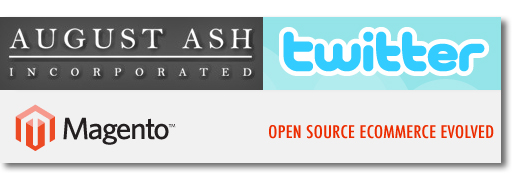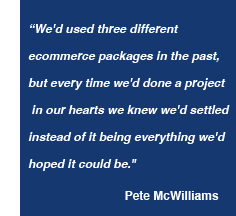
Sit back and let me tell you a story about a game-changing open source ecommerce project, an emerging web development firm in Bloomington, and how they discovered this project and I, in turn, discovered them. It’s illustrative of how Internet and Web connections are changing everything from value discovery to customer satisfaction to how awareness of an emerging company can happen if they’re in-the-game and leveraging new social media tools.
Last year I was performing some due diligence for a client on ecommerce software. Stunned by how poorly executed most open source ecommerce projects were, I was delighted when happenstance brought me to this blog with a link to an open source ecommerce package called MagentoCommerce. After thirty minutes on the site, scanning posts in the forum and looking at the demos, I realized that the sheer scope of the energy, effort and enthusiasm the community was exhibiting around this open source project was going to raise the bar quite high for any other ecommerce offering…whether commercial or open source.
Local Bloomington firm, August Ash, Inc., also found MagentoCommerce in much the same way I had, though they came upon it in early 2007. Turns out they are the only known Minnesota firm to have already launched sites on this new open source package (which shipped the very first version on March 31, 2008) and you also might be surprised to learn why they took the risk on such unproven software, how doing so actually aligns with their focus on quality and customer satisfaction, and how I came to learn about August Ash in the first place through the use of social media.
Over nine years ago and right out of college, Erich Hanson started what would become known as August Ash, Inc. A programmer as a teenager, Hanson went on to be educated in physics and astrophysics and began doing web development in 1999 for friends and family, primarily as a hobby.
His primary focus at the time was using his science and technology understanding to perform user interface design for touch screens on medical devices, which turned out to be informative for their current work in Web development. These early efforts also informed one key value of the firm Hanson has built: a hyperfocus on outcomes and results from every Web-based creation they deliver for clients.
 Evolving from that base, moving in to internet marketing and Web design, August Ash has grown in to a fifteen person firm (expanding soon since they’re on the hunt for developers as business accelerates).
Evolving from that base, moving in to internet marketing and Web design, August Ash has grown in to a fifteen person firm (expanding soon since they’re on the hunt for developers as business accelerates).
Having been on the popular microblogging messaging system, Twitter, for some time, I chose to follow the MagentoCommerce team Twitter account. Out of the blue came a “tweet” from them that congratulated “mn_web_design” for launching yet another MagentoCommerce site.
Immediately upon seeing that I thought, “Who in Minnesota is using MagentoCommerce?” and went to that Twitter account and saw this, “August Ash, Inc. is a Minneapolis web design firm specializing in Internet marketing and custom web development solutions.”
I sent a blind “info@” email to the firm (there are no names on the contact page) and got a nice response back from founder Erich Hanson. He and I grabbed lunch last week and had a subsequent phone interview with he and his head of development, Pete McWilliams, on Friday. I just had to know how and why a small firm hyperfocused on customer satisfaction, quality, and high value, would take a flyer on a 1.0 version of an open source ecommerce package.
Though I was quite impressed by the vision, values and mission Erich Hanson and team exude and have clearly translated in to quality work for their client base now numbering 250+, I was primarily curious about their decision-making process on following, learning and subsequently launching sites on what would be a 1.0 version of MagentoCommerce.
Their recent couple of years of development activities had been done using the Zend Framework, an open source, object-oriented web application development framework, one whose open source community goal is toward simplifying web development while promoting best practices in the PHP developer community.
Starting on version .2 of the Zend Framework, August Ash had worked toward taking best practices developed for clients and saving them as reusable code bases (and striving to build their own code library), in an attempt to accelerate their Web development speed, save costs for their clients and themselves, and be able to create ever more robust sites achieving results.
“We’d used three different ecommerce packages in the past, but every time we’d done a project, in our hearts we knew we’d settled instead of it being everything we’d hoped it could be,” McWilliams stated. Hanson chimed in and explained that whenever any client wanted to add a custom feature, it was a daunting task to ensure it would scale strategically, be flexible now and in the future, and be something they could support for their clients.
McWilliams went on, “As we kept tabs on MagentoCommerce’s progress and watched the ecosystem around it grow, we grew more and more excited.” They started experimenting with the beta software and “it did almost everything out of the box,” Hanson made clear to me.
According to both Hanson and McWilliams, using pre-release beta software and launching on a version 1.0 product was actually less risk than other approaches they’d done in the past:
- Varien, the company who started and is driving MagentoCommerce, put a ton of work into the user interface. The backend, administration interfaces that clients use with other software packages are horrendous and not terribly usable
- Though the learning curve for developers is steep, once in place both the frontend and backend are so easy to use that training and support is significantly less than any other project they’ve done to date
- Clients have a much easier time of managing and self-supporting their use of a MagentoCommerce deployment.
While both said that it’s clearly a 1.0 release and there is much work to do and features to add, what they have done “is so well done it’s less risk and we’re creating our own code to extended the software and will be contributing back into the community to make MagentoCommerce even better,” Hanson proudly said.
Besides meeting some new folks, learning about a firm that I will undoubtedly refer clients to, and deepening my understanding of the pros-n-cons of MagentoCommerce, I’m delighted with the connectedness and access social media tools provide. From the blogs that first informed us both about MagentoCommerce to the use of Twitter that ultimately brought us together, this is yet one more piece of evidence that Minnesota innovation in Internet & Web technology is growing everywhere.